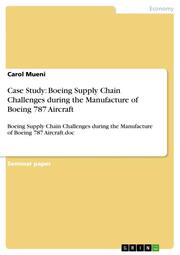Detailansicht
Case Study: Boeing Supply Chain Challenges during the Manufacture of Boeing 787 Aircraft
Boeing Supply Chain Challenges during the Manufacture of Boeing 787 Aircraft.doc
ISBN/EAN: 9783656554080
Umbreit-Nr.: 6001299
Sprache:
Englisch
Umfang: 24 S.
Format in cm: 0.3 x 21 x 14.8
Einband:
kartoniertes Buch
Erschienen am 16.12.2013
Auflage: 1/2013
- Zusatztext
- Seminar paper from the year 2010 in the subject Business economics - Supply, Production, Logistics, grade: A, The University of Liverpool, language: English, abstract: Founded in 1916, at the Puget Sound location in Washington State USA, Boeing is the largest aircraft company in the world, manufacturing commercial aircrafts, military aircrafts, satellites, weapons and electronic defence systems. It has a history of being the best aircraft company in leadership and innovation to design leading aircraft designs. The company uses advanced technology, engineering skills and innovative leadership to design and develop its products. As a result, it is the best in the USA and worldwide, serving many other nations with commercial and military aircraft. To remain innovative and competitive, in 1990s Boeing started considering a replacement of the Boeing 767, due to slow rate of sales. By 16th December 2003, Boeing announce that it was going to assemble the 787 jet in its factory located at Everett Washington. In building this plane, the company focused on reducing the time line from 6 years to 4 years. Instead of contracting the plane from scratch, it was going to outsource parts and issue sub-contracts to other companies in other nations. The process of production requires raw materials and labor, which take time to procure and manage for the companies to come up with the right products. For the Boeing company to produce the 787 parts in the USA, it would have incurred high costs in procurements and a lot of management logistics. To cut down these costs, outsourcing was a nice way out that provided the company with the ability to enjoy the availability of skilled labor and raw materials in the outsourcing companies.
